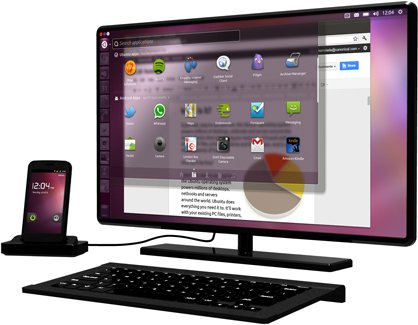Canonical is pushing to move Ubuntu beyond Desktop PC, and we’ve already seen some mockups for Ubuntu Smartphones and the recent Ubuntu TV announcement. The Ubuntu smartphone is not there yet, but Canonical has another idea: running Ubuntu Desktop on your multi-core Android smartphone connected to a TV/Monitor via its HDMI or MHL interface, making Canonical, another company joining “your smartphone is your laptop” trend.

Ubuntu for Android will provide a full desktop experience and include office software (which apparently is Google Docs…) , web browsers (Chromium and Firefox), an email clients (Thunderbird) and media applications on Android phones docked to a screen and keyboard. Canonical claims the transition between Android and Ubuntu is seamless thanks to tight integration with the Android service layer.
Ubuntu and Android share the same kernel. When docked, the Ubuntu OS boots and runs concurrently with Android. This allows both mobile and desktop functionality to co-exist in different runtimes. When you are on the go, Ubuntu switches off and all CPU cores are used by Android.
Shared services and applications are delivered using a Convergence API module which ensures the tight integration between desktop and mobile environments, says the company.
Interestingly, Ubuntu solution does not seem to be based on virtualization as it runs the same kernel and instead runs 2 middleware (Android and Ubuntu UI) on top on that kernel. This technical solution should be more efficient than baremetal hypersivors such as Codezero, but requires the operating systems to share the same kernel, so for example, a combo iOS/Ubuntu would not work.
Most of your user data such as contacts, calendar, documents, web browser history and bookmarks will be synchronized between Android and Ubuntu probably thanks to Chromium/Firefox synchronization feature and Google Calendar and Google Docs cloud storage. I suppose emails will be synchronized though the use of the IMAP protocol, although enterprise users might use another solution.
You can also answer/make calls and send SMS from the Desktop.
Update: Here’s a video demo of Ubuntu for Android. It can also detect if the smartphone is connected to a TV and run Ubuntu TV instead. Pretty neat…
Technical Requirements
- Dual-core 1GHz CPU
- Video acceleration: shared kernel driver with associated X driver; Open GL, ES/EGL
- Storage: 2GB for OS disk image
- HDMI: video out with secondary frame buffer device
- USB host mode
- 512 MB RAM
Your phone will also need to come with a Dock, as Ubuntu will have to detect when the phone is docked.
Canonical now focuses on finding phone manufacturers and targets enterprise users by promising to lower their TCO as they would only need one device (a smartphone) getting rid of the extra laptop and maintenance associated with it.
After so many years, 2012 may finally be the year of the Linux Desktop (on smartphones).
You can find more information on Canonical’s Ubuntu For Android page.

Jean-Luc started CNX Software in 2010 as a part-time endeavor, before quitting his job as a software engineering manager, and starting to write daily news, and reviews full time later in 2011.
Support CNX Software! Donate via cryptocurrencies, become a Patron on Patreon, or purchase goods on Amazon or Aliexpress




